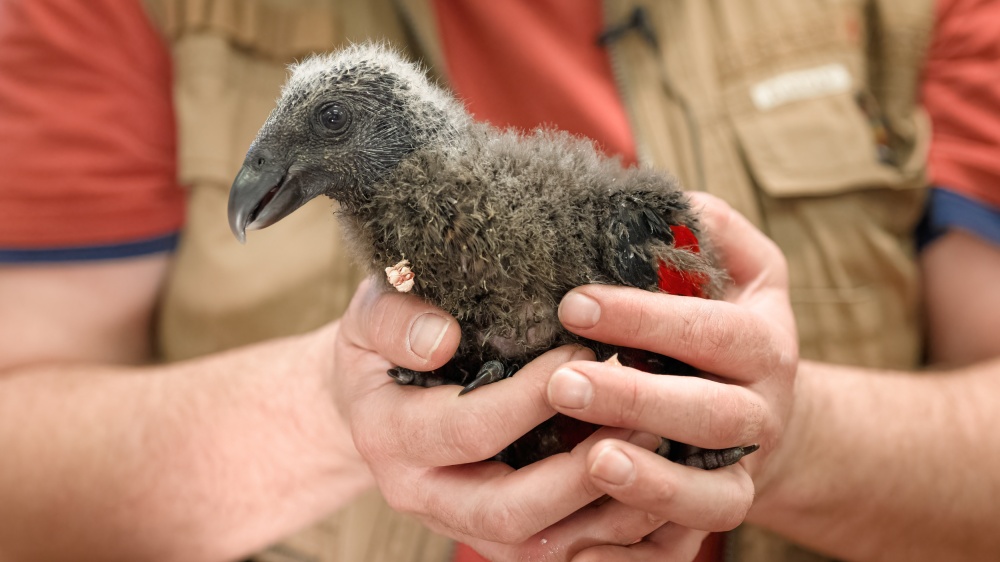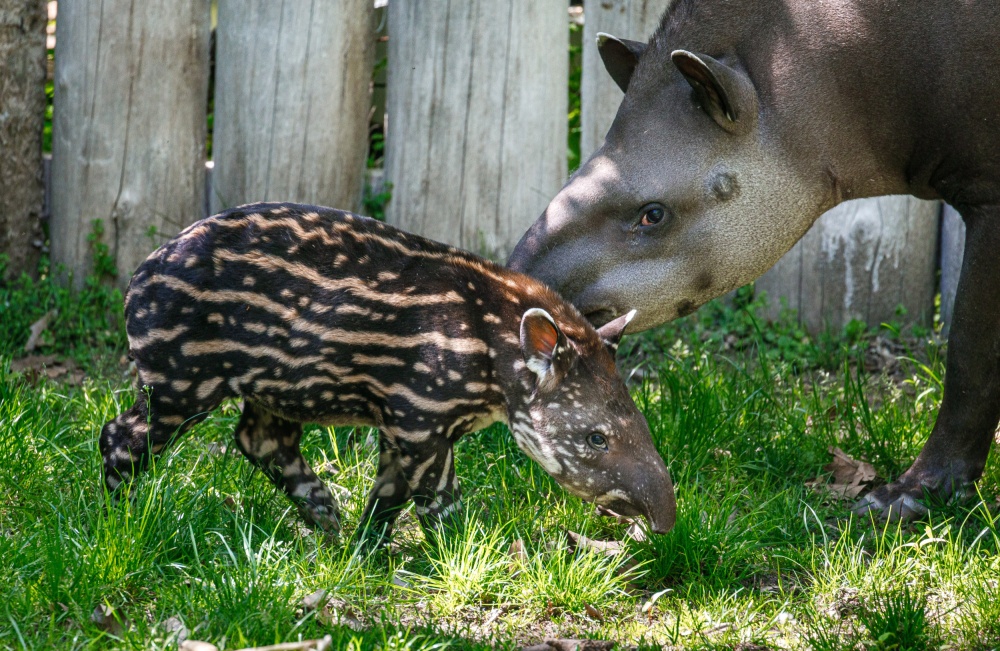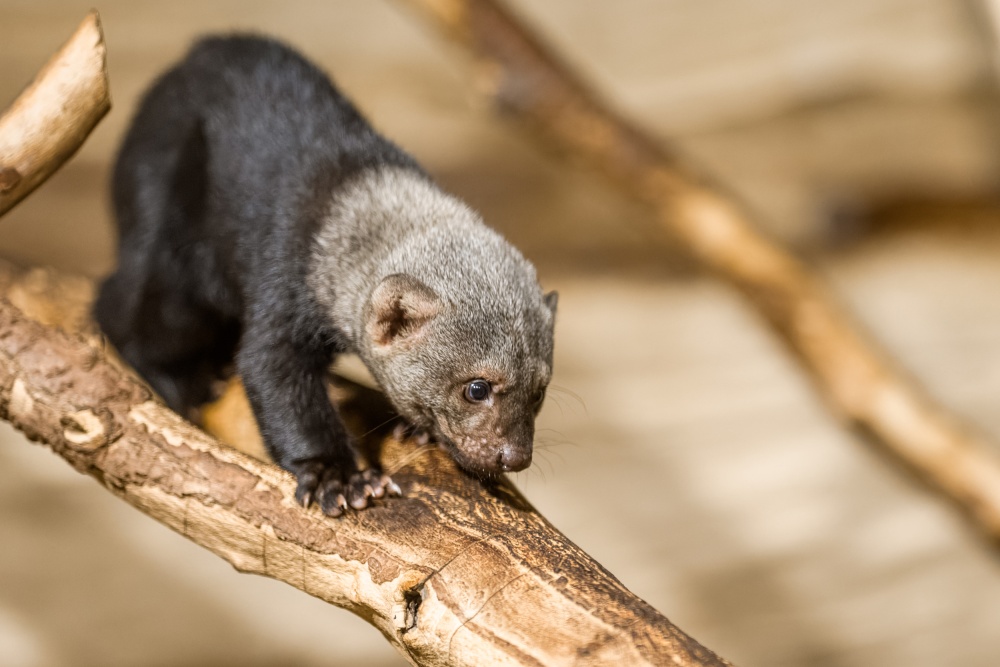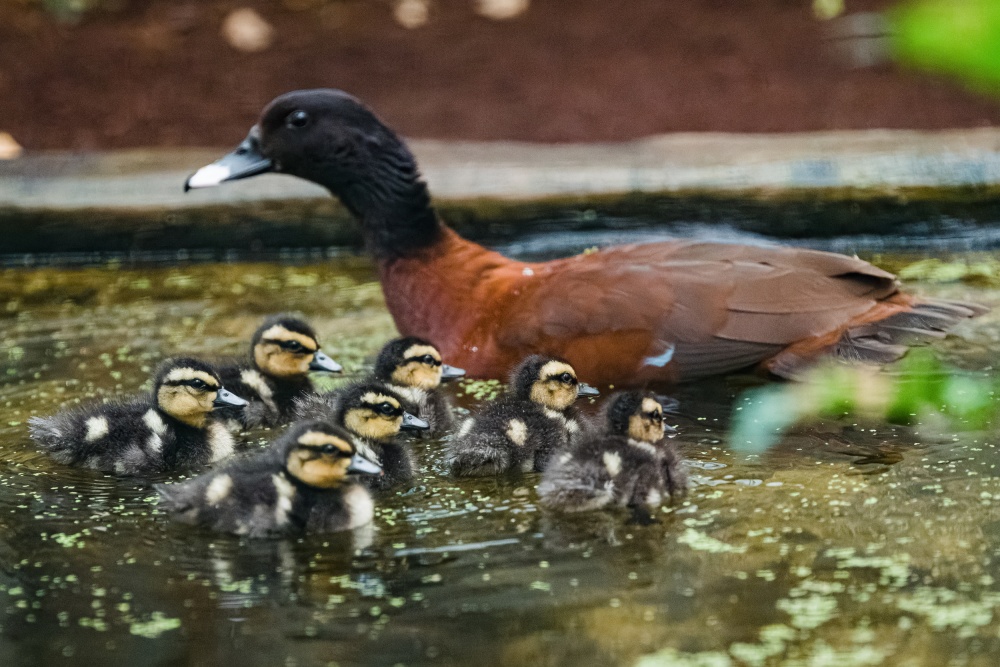Important births at Prague Zoo in 2021
20. 12. 2021
Pesquet’s parrot chicks, a female South American tapir calf, the first ever tayra quadruplets or Hartlaub’s duck ducklings - these are just some of the species that, from a professional point of view, represent Prague Zoo’s successes in breeding over the last year.

The first Pesquet’s parrot chick of this year hatched on January 28th. Pictured here at the age of 48 days. Photo: Petr Hamerník, Prague Zoo
“Since the start of this year to this day, there have been 1,027 young animals from 199 different species - mammals, birds, reptiles, amphibians and fish - born or hatched at Prague Zoo. Of course, more are on the way," said Miroslav Bobek, Prague Zoo’s director. "Some of them, such as Jasmína the female tapir or the tayra quadruplets, have attracted a lot of interest from the media and the public alike, while others have taken a backseat. However, even they are important offspring that we would like to introduce you to at some time.”
 PESQUET’S PARROT
PESQUET’S PARROT
Psittrichas fulgidus
This is the second chick that the pair of parrots are rearing in Prague Zoo’s breeding facilities this year. Pesquet’s parrots face the loss of their natural habitat due to deforestation in New Guinea, where they are often hunted for their beautiful long feathers. Hence, four years ago, the species was placed in the vulnerable category on the IUCN Red List of Threatened Species. Prague Zoo is one of seven European and the only Czech zoo to breed these parrots.
The first Pesquet’s parrot chick hatched in Prague Zoo at the end of January and the next one in early October. This chick is the first to be naturally raised in a European zoo. Its parents are rearing it in a nest box, which it should leave at the end of the year. It is also the third chick of this species to be successfully bred here.
Pesquet’s parrot breeding at Prague Zoo dates back to 2014, when the first female arrived, followed two years later by two males and another female. As the market price of this parrot is relatively high, Prague Zoo acquired these individuals from a private breeder in exchange for some of their offspring.
The Pesquet’s parrot is at home in the rainforests that cover the lower-lying areas of the New Guinea highlands. The locals hunt it for its red feathers, which they use to decorate their headdresses. According to a Wildlife Conservation Society survey, 8% of its total estimated population is killed every year to satisfy this demand.
The Pesquet’s parrot does not nest in an abandoned tree cavity like most other parrots. To stimulate nesting, they need to hollow out a cavity in the rotting trunk themselves, which they do using their conspicuous hook-like beak. Therefore, the keepers at Prague Zoo prepared a trunk with a cavity filled with wood shavings to evoke this nesting adaptation.
The parrot’s sexual dimorphism is also interesting, compared to the female, the male has extra red feathers forming a spot behind the eye. It has a highly specialised diet. Despite its large weight - up to one kilogram - it feeds exclusively on fruit, nectar and fruit juices.
 SOUTH AMERICAN TAPIR
SOUTH AMERICAN TAPIR
Tapirus terrestris
One of the most attractive young of the past season was a striped South American tapir calf. In 2002, due to hunting and habitat loss, this odd-toed ungulate was listed as vulnerable on the IUCN Red List of Threatened Species. The female tapir, which was born at Prague Zoo in April this year, is more valuable as she carries unique genes that, so far, have not been present in European breeding.

The female South American tapir, Jasmína, is the first calf from the female Taluen, who came to Prague Zoo two years ago from French Guiana. Thanks to this, the European Breeding Programme (EEP) has been enriched with completely new genes and Prague Zoo was one of the few institutions to receive a recommendation to reproduce from a breeding pair. The calf’s father, Tex, also has a very interesting non-European origin, having arrived from the USA fifteen years ago. According to the breeding coordinator, the newborn female is the first recommended calf to be born in the programme for several years.
She is now almost seven months old and has almost lost her spots and stripes, which are a characteristic of tapir calves, and is gradually gaining the dark brown colouring of the adults. Prague Zoo first bred South American tapirs as early as 1950-1957. Breeding was resumed in 2004 and the first calf, a male named Heřmánek, was born here two years later. Jasmína is the fourth new arrival of this species here.
The South American tapir inhabits the Amazon rainforest east of the Andes in an area that includes Venezuela, Colombia and Guyana in the north, Brazil and Argentina in the south and Bolivia, Peru and Ecuador in the west. It is an odd-toed ungulate, although it has four toes on its hind feet and three on its front. Perhaps the tapir’s most striking feature is its elongated upper lip and nostrils, which together form a sort of short trunk. It uses it in much the same way as an elephant - to pluck plant food, as an extremely sensitive smell organ, and for breathing when in swamps or water, to which it is very closely bound. It cools itself in water, feeds on aquatic plants and seeks shelter in the water when threatened. It can swim, dive and even walk on the riverbed.
It is active during dusk and at night. It spends the day hidden in the dense forest undergrowth and, despite its size, often escapes attention. It is mostly solitary, and only during courtship do tapirs seek each other out using scent marking and various vocal displays.
TAYRA
Eira barbara
Eira, tayra, irara or high-woods dog - these are all names for this elegant and slender mustelid from Central and South America. At the end of the summer, Prague Zoo was proud to boast the first ever quadruplets to be born in the Czech Republic. Only two European zoos have bred this charming omnivore from the weasel family in the past year.

Tayras usually give birth to one or two young. Quadruplets are most unusual for this species, and this is the first time they have been born in the Czech breeding programme. Three females and one male saw the light of day on the last day of August. Their mother is a six-year-old female, bred in Prague Zoo, and their father is an eleven-year-old male, who came here in 2011 from Papiliorama a zoo in Switzerland. Prague Zoo has been breeding tayras since 2004 and the first success took place a decade ago. It was the first time this species had bred in the Czech Republic.
The tayra is most closely related to martens and grisons. In the wild, it lives in various forested and scrubby habitats from central Mexico to northern Argentina and Trinidad. Due to its large range, scientists have distinguished approximately nine subspecies. It is not seriously endangered, but their populations are slowly declining.
As with all mustelids, it is highly adaptable and builds its burrows in tree cavities as well as in dense undergrowth or rock crevices. It generally forages its food at dusk. It is very adept at tree-climbing, where it also often hunts small, clawed monkeys, whereas on the ground it preys on rodents or reptiles, especially iguanas. It supplements its diet with berries.
The natives call the tayra “cabeza de viejo”, i.e., the head of an old man due to the wrinkles on its face. It is sometimes called the sun marten because of the light hair on its neck and head, which glows in the sunlight. This name also highlights the fact that the tayra is one of the few weasel-like carnivora that are active during the day, which makes it a very attractive species for Prague Zoo’s visitors.
HARTLAUB’S DUCK
Pteronetta hartlaubii
The seven Hartlaub’s duck hatchlings, which hatched at Prague Zoo this April, are a huge breeding success. These are the first ducklings of this species in the framework of the Union of Czech and Slovak Zoological Gardens. Prague Zoo is one of only three institutions in Europe to have bred these waterfowl.

The five-year-old male and two-year-old female managed to raise the chicks on their own. Hartlaub’s ducks normally nest in tree cavities, so the ducklings were raised in a box placed one and a half metres above the ground. The downy, brown and yellow chicks had to jump from this height, just as they would in the wild.
Prague Zoo started breeding Hartlaub’s ducks last June, when it acquired two unrelated pairs from Pinola Conservancy a specialized, private breeding centre in Louisiana, USA. Although specimens of this species have been brought to Europe before, they have rarely been able to breed - the last time was two decades ago. Currently, this rarely bred, monotypic representative of its genus, is only kept in Czech zoos and cannot be seen in any other European zoo.
The Hartlaub’s duck lives mostly in forested wetlands, lakes or rivers in West and Central Africa. This dabbling duck predominantly forages for food at night, being equally at home in water, in marshes and on land. It lives very discreetly. It often rests on low branches and roosts in trees, and so far, no nest has been found in the wild.








